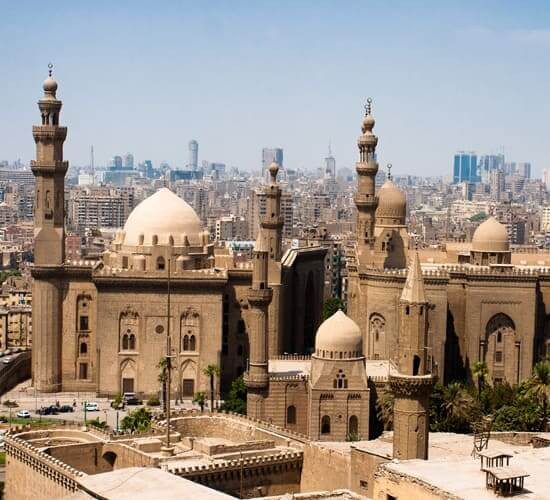| Rosette Rafaat | 2024-04-22 11:05:24 |
The Al-Rifa'i Mosque located amidst the bustling streets of Cairo, Egypt, lies a timeless testament to Islamic architecture and cultural heritage. This architectural marvel stands as a symbol of religious devotion and historical significance, attracting visitors from all corners of the globe. In this article, we delve into the rich history, intricate design, and spiritual significance of the Al-Rifa'i Mosque, inviting readers to explore its grandeur and beauty.
A Glimpse into History of Al-Rifa'i Mosque
The history of Al-Rifa'i Mosque is as fascinating as its architecture. Commissioned by Khushyar Hanim, the mother of Khedive Ismail, in 1869, this mosque was initially intended to be the resting place for members of the Egyptian royal family. However, construction delays and political upheavals led to its completion nearly four decades later, in 1912, during the reign of Sultan Hussein Kamel.
Architectural Marvel of the Al-Rifa'i Mosque
One cannot help but marvel at the architectural prowess displayed in the construction of Al-Rifa'i Mosque. Designed by renowned architect Hussein Fahmy Pasha, the mosque seamlessly blends various architectural styles, including Ottoman, Mamluk, and Gothic Revival, resulting in a visually stunning masterpiece. The exterior façade, adorned with intricate carvings and towering minarets, captivates the imagination of onlookers, while the spacious interior exudes a sense of tranquility and reverence.
Intricate Design Elements
The interior of Al-Rifa'i Mosque is a testament to meticulous craftsmanship and artistic ingenuity. As visitors step inside, they are greeted by a vast prayer hall adorned with ornate marble columns, intricately patterned walls, and beautifully crafted stained glass windows. The mihrab, indicating the direction of Mecca, serves as the focal point of the prayer hall, drawing worshippers into a state of spiritual reflection and devotion.
The mausoleum, located within the mosque complex, houses the tombs of several members of the Egyptian royal family, including Khedive Ismail, Khedive Tawfiq, and King Farouk. The tombs are adorned with exquisite marble carvings and intricate calligraphy, reflecting the grandeur and opulence of Egypt's royal past.
Spiritual Significance
Beyond its architectural splendor, Al-Rifa'i Mosque holds profound spiritual significance for Muslims around the world. As a place of worship and contemplation, it provides a sanctuary for believers to connect with the divine and seek solace in prayer. The mosque's serene ambiance and awe-inspiring beauty inspire a sense of reverence and humility, reminding visitors of the timeless teachings of Islam and the importance of spiritual reflection.
Cultural Heritage
In addition to its religious significance, Al-Rifa'i Mosque is a symbol of Egypt's rich cultural heritage and architectural legacy. Its towering minarets and majestic domes stand as a testament to the country's enduring tradition of craftsmanship and artistic expression. As one of Cairo's most iconic landmarks, the mosque serves as a focal point for cultural exchange and dialogue, welcoming visitors from diverse backgrounds to explore its history and significance.
Preservation Efforts
Over the years, Al-Rifa'i Mosque has undergone various restoration and preservation efforts to ensure its longevity and integrity. From structural repairs to the conservation of artistic elements, these initiatives aim to safeguard the mosque's architectural heritage for future generations to appreciate and enjoy. Through careful stewardship and community engagement, stakeholders continue to uphold the legacy of Al-Rifa'i Mosque as a cherished cultural treasure.
Conclusion
In conclusion, Al-Rifa'i Mosque stands as a shining example of Islamic architecture and cultural heritage, captivating the hearts and minds of visitors with its timeless beauty and spiritual significance. From its intricate design elements to its profound historical legacy, the mosque invites us to embark on a journey of discovery and appreciation, celebrating the rich tapestry of human creativity and devotion. As we gaze upon its majestic domes and towering minarets, let us be reminded of the enduring power of faith and the boundless potential of architectural expression to inspire and uplift the soul.
FAQs
Who is buried in Al Rifai mosque?
Al-Rifa'i Mosque is the final resting place for several members of Egypt's royal family, including Khedive Ismail, Khedive Tawfiq, and King Farouk. Their tombs, adorned with marble carvings and calligraphy, are housed within the mosque's mausoleum, adding to its historical significance.
What is the architecture of the Al Rifa I mosque?
The architecture of Al-Rifa'i Mosque is a blend of Ottoman, Mamluk, and Gothic Revival styles. Its exterior features intricate carvings, towering minarets, and grand domes. Inside, visitors encounter a spacious prayer hall with marble columns, patterned walls, and stained glass windows, creating a serene and awe-inspiring ambiance.
